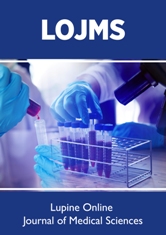
Lupine Publishers Group
Lupine Publishers
Menu
ISSN: 2641-1725
Mini Review(ISSN: 2641-1725) 
The Role of Thromboelastography and Rotational Thromboelastometry in Deep Vein Thrombosis Diagnosis and Management Volume 1 - Issue 1
Chaoqin Mao1, Yueshan Xiong2 and Cheng Fan3*
- 1Department of Rehabilitation, Union Hospital, Tongji Medical College, Huazhong University of Science and Technology, Wuhan 430022, China
- 2Department of Mathematics, School of Mathematics and Statistics, Huazhong University of Science and Technology, Wuhan 430074, China
- 3Department of Geriatrics, Union Hospital, Tongji Medical College, Huazhong University of Science and Technology, Wuhan 430022, China
Received: February 14, 2023; Published: February 24, 2023
*Corresponding author: Cheng Fan, Department of Geriatrics, Union Hospital, Tongji Medical College, Huazhong University of Science and Technology, Wuhan 430022, China
DOI: 10.32474/LOJMS.2023.06.000241
Abstract
Deep Vein Thrombosis (DVT) is a serious condition that can lead to significant morbidity and mortality in hospitalized patients. Early identification and prevention of DVT-related coagulation abnormalities are crucial for patient outcomes. While Conventional Coagulation Assays (CCAs) provide limited information on the clotting of whole blood and are of limited value in the assessment of coagulation status of patients with DVT. Whole-blood viscoelastic coagulation tests like Thromboelastography (TEG) and Rotational Thromboelastometry (ROTEM) offer a more comprehensive assessment of coagulation status in patients with DVT. These tests have shown promise in identifying individuals at increased risk of DVT and detecting related hypercoagulability. TEG/ROTEM may also play a role in guiding anticoagulation therapy for these patients. We recommend incorporating TEG/ROTEM into the coagulation testing regimen to improve the accuracy of prophylaxis, diagnosis, and management of DVT.
Keywords: Deep vein thrombosis; Thromboelastography; Rotational Thromboelastometry; Hypercoagulability
Introduction
Deep Vein Thrombosis (DVT) is a prevalent and growing global health issue that frequently affects the lower limbs, often starting in the calf and spreading upward [1]. The incidence of DVT is estimated to be 1.6 cases per 1000 individuals annually [1,2], and is on the rise due to factors such as aging populations, increasing prevalence of comorbidities such as obesity, heart failure, and cancer, and improved diagnostic testing methods [3,4]. Symptoms of DVT can include pain, swelling, redness, and dilated superficial veins in the affected limb [3]. Compression ultrasonography and D-dimer testing are commonly used for initial diagnosis [5,6]. Standard treat ment for DVT involves anticoagulation to prevent further clotting and embolization [7]. The coagulation status of patients is typically monitored through Conventional Coagulation Assays (CCAs) including Prothrombin Time (PT), activated Partial Thromboplastin Time (aPTT), Thrombin Time (TT), International Normalized Ratio (INR) and, Platelet Count (PLT), to guide the use of anticoagulants. However, challenging complications of DVT such as life-threatening hemorrhage and recurrence after discharge are frequently observed, indicating the poorly monitoring of patients’ coagulation status by CCAs [3,5,7]. PT, aPTT, TT and INR end with the formation of the first fibrin strand and indicate deficiencies in clotting factors while the PLT measures the number of platelets [8,9]. The coagulation process can be complex and snapshots of isolated parts of it may not provide sufficient information on the clotting of whole blood [10]. As a result, there has been an increase in interest in whole-blood viscoelastic coagulation tests, such as Thromboelastography (TEG) and Rotational Thromboelastometry (ROTEM), which can provide real-time information on the sufficiency of hemostasis and detect coagulation defects [11-13]. These tests are based on the changes in the viscosity of blood as it coagulates and take into account the fibrin and platelet-dependent cross-linking between whole blood [14]. This provides a more comprehensive view of the coagulation process than traditional plasma-based coagulation tests [11]. TEG/ROTEM tests, allowing faster identification of coagulation disorders than CCAs, have been shown to be superior to traditional tests in many clinical fields [15], including hemophilia, sepsis, coronary artery bypass, trauma, pregnancy and postpartum hemorrhage [11-13,16-20]. In this paper, we provide an overview of the application of TEG/ROTEM in the management of DVT.
TEG/ROTEM for the Prediction and Assessment of the Risk of DVT
The risk factors for developing DVT include trauma, injury, and surgery, which can lead to disruptions in coagulation and increase the risk of bleeding followed by a hypercoagulable state, making DVT more likely to occur [2-4]. To prevent this life-threatening complication, a comprehensive evaluation of coagulation abnormalities, early identification, and targeted prophylaxis is necessary. In recent decades, the utility of TEG in assessing DVT risk in patients has been demonstrated in multiple studies. A prospective cohort study by Brill, et al. [21] evaluated 938 trauma patients who were at high risk of developing DVT, using TEG in admission and ultrasound surveillance. The results showed that 85% of patients were hypercoagulable based on TEG results and that hypercoagulability was associated with a higher rate of lower-extremity DVT [21]. TEG was found to predict DVT with a high sensitivity of 91.9%, making it a useful metric for assessing DVT risk. Another study of over 1800 patients with severe extremity fractures found that TEG values ≥65 and ≥72 were independent predictors of DVT and pulmonary embolus [22]. This indicates that TEG can effectively identify patients at increased risk of in-hospital DVT and pulmonary embolus. Other studies have also shown the predictive role of TEG in DVT, including in patients undergoing neurosurgery and gastric cancer patients after surgery [23,24]. Overall, these results suggest that TEG has the capacity to assess the risk of DVT and predict its occurrence, making it a valuable tool in DVT risk assessment and prevention.
TEG/ROTEM for the Identification and Detection of Hypercoagulability related to DVT
Patients in a state of hypercoagulability are shown to be at a significantly higher risk for DVT. Timely detection and vigilant monitoring of hypercoagulability is crucial in reducing the occurrence of thromboembolic events in surgical or injured patients. The usefulness of TEG in detecting hypercoagulability is widely recognized recently [9,25-27]. Park, et al. [26] performed TEG on critically ill and nonbleeding patients with trauma and found TEG was more sensitive than CCAs in detection of hypercoagulable state in these patients. Spiezia, et al. [28] also reported that ROTEM was a useful tool to detect DVT-related hypercoagulability, particularly on maximum clot firmness and the area under curve values from ROTEM. A strong correlation was observed between the hypercoagulable state in the acute phase of DVT and the risk of DVT development. In addition, Mao [9] and her team observed that the TEG parameters of angle, MA, clot strength (G), and coagulation index (CI) were significantly elevated, while K was significantly reduced, in patients with DVT compared to healthy individuals, indicating a hypercoagulable tendency in DVT patients. However, no significant differences in aPTT, PT, or PLT were observed between the patients and controls. The team also found that TEG was the most effective method for identifying DVT when compared to conventional coagulation assays (CCAs), which further suggests the clinical implication of TEG in DVT identification [9]. Moreover, a systematic review and meta-analysis based on 8939 patients showed TEG/ROTEM possessed a great ability to identify hypercoagulability in trauma and operative patients [27]. Interestingly, the study revealed that among all the TEG parameters, MA was consistently used to diagnose hypercoagulability and predict venous thromboembolism after traumatic injury and surgical intervention. The results indicate that MA has satisfactory specificity and sensitivity in detecting DVT [27]. Taken together, the above studies suggest that TEG is effective in identifying DVT-related hypercoagulability and can serve as an indicator of DVT.
TEG/ROTEM for the Management of DVT
The main treatment for DVT is anticoagulation, which has the goal of reducing mortality, preventing the growth of blood clots, reducing the likelihood of recurrence, and reducing the risk of post-thrombotic syndrome. Anticoagulant options for DVT include low molecular weight heparin, dabigatran, rivaroxaban, and apixaban [5]. TEG has been found to be significantly more sensitive to the presence of heparin than other coagulation tests, such as aPTT, PT, or INR [10,29]. In a study of 205 patients receiving low molecular weight heparin anticoagulation therapy in a surgical intensive care unit, Wu et al. observed that the R value of TEG was associated with both the occurrence of DVT and the risk of hemorrhagic complications. These findings suggest that TEG may be useful in guiding low molecular weight heparin treatment for patients with DVT [30]. Solbeck [31] and colleagues found that the R value of TEG correlated strongly with the Hemoclot and Ecarin clotting time, which are current gold-standard tests for assessing dabigatran. This suggests that TEG may be a rapid and precise method for monitoring dabigatran treatment in whole blood. Although more research is needed to fully establish the effectiveness of TEG in guiding anticoagulation treatment for DVT, these findings provide promising insight into its potential use in managing patients with DVT
Conclusion
TEG/ROTEM, in contrast to CCAs, evaluates the interactions between the cellular and plasma components of the coagulation process, providing a comprehensive assessment of whole-blood coagulation. Early research suggests that TEG/ROTEM may be useful in identifying individuals at risk for DVT, detecting hypercoagulability related to DVT, and diagnosing the condition itself. While further studies are necessary to fully understand the role of TEG/ROTEM in the management of DVT, we believe that they have the potential to become valuable tools in both clinical and research settings. It is our suggestion that TEG/ROTEM be used in conjunction with other coagulation tests to improve the accuracy of prophylaxis, diagnosis, and management of DVT.
References
- Strijkers RH, Cate-Hoek AJ, Bukkems SF, Wittens CH (2011) Management of deep vein thrombosis and prevention of post-thrombotic syndrome. BMJ 343: d5916.
- Stubbs MJ, Mouyis M, Thomas M (2018) Deep vein thrombosis. BMJ 360: k351.
- Di Nisio M, van Es, Büller HR (2016) Deep vein thrombosis and pulmonary embolism. Lancet 388: 3060-3073.
- Ruskin KJ (2018) Deep vein thrombosis and venous thromboembolism in trauma. Curr Opin Anaesthesiol 31: 215-218.
- Kruger PC, Eikelboom JW, Douketis JD, Hankey GJ (2019) Deep vein thrombosis: update on diagnosis and management. Med J Aust 210: 516-524.
- Bernardi E, Camporese G (2018) Diagnosis of deep-vein thrombosis. Thromb Res 163: 201-206.
- Streiff MB, Agnelli G, Connors JM, Crowther M, Eichinger S, et al. (2016) Guidance for the treatment of deep vein thrombosis and pulmonary embolism. J Thromb Thrombolysis 41: 32-67.
- Bonar RA, Lippi G, Favaloro EJ (2017) Overview of Hemostasis and Thrombosis and Contribution of Laboratory Testing to Diagnosis and Management of Hemostasis and Thrombosis Disorders. Methods Mol Biol 1646: 3-27.
- Mao C, Xiong Y, Fan C (2021) Comparison between thromboelastography and conventional coagulation assays in patients with deep vein thrombosis. Clinica Chimica Acta 520: 208-213.
- Karon BS (2014) Why is everyone so excited about thromboelastrography (TEG)? Clin Chim Acta 436: 143-148.
- Othman M, Kaur H (2017) Thromboelastography (TEG). Methods Mol Biol 1646: 533-543.
- Liu C, Guan Z, Xu Q, Zhao L, Song Y, et al. (2016) Relation of thromboelastography parameters to conventional coagulation tests used to evaluate the hypercoagulable state of aged fracture patients. Medicine (Baltimore) 95: e3934.
- Wang Z, Li J, Cao Q, Wang L, Shan F, et al. (2018) Comparison Between Thromboelastography and Conventional Coagulation Tests in Surgical Patients With Localized Prostate Cancer. Clin Appl Thromb Hemost 24: 755-763.
- da Luz LT, Nascimento B, Rizoli S (2013) Thrombelastography (TEG®): practical considerations on its clinical use in trauma resuscitation. Scand J Trauma Resusc Emerg Med 21: 29.
- Figueiredo S, Tantot A, Duranteau J (2016) Targeting blood products transfusion in trauma: what is the role of thromboelastography? Minerva Anestesiol 82: 1214-1229.
- Young G, Sørensen B, Dargaud Y, Negrier C, Brummel-Ziedins K, et al. (2013) Thrombin generation and whole blood viscoelastic assays in the management of hemophilia: current state of art and future perspectives. Blood 121: 1944-1950.
- Müller MC, Meijers JC, Vroom MB, Juffermans NP (2014) Utility of thromboelastography and/or thromboelastometry in adults with sepsis: a systematic review. Crit Care 18: R30.
- Rafiq S, Johansson PI, Zacho M, Stissing T, Kofoed K, et al. (2012) Thrombelastographic haemostatic status and antiplatelet therapy after coronary artery bypass surgery (TEG-CABG trial): assessing and monitoring the antithrombotic effect of clopidogrel and aspirin versus aspirin alone in hypercoagulable patients: study protocol for a randomized controlled trial. Trials 13: 48.
- Da Luz LT, Nascimento B, Shankarakutty AK, Rizoli S, Adhikari NK (2014) Effect of thromboelastography (TEG®) and rotational thromboelastometry (ROTEM®) on diagnosis of coagulopathy, transfusion guidance and mortality in trauma: descriptive systematic review. Crit Care 18: 518.
- Shreeve NE, Barry JA, Deutsch LR, Gomez K, Kadir RA (2016) Changes in thromboelastography parameters in pregnancy, labor, and the immediate postpartum period. Int J Gynaecol Obstet 134: 290-293.
- Brill JB, Badiee J, Zander AL, Wallace JD, Lewis PR, et al. (2017) The rate of deep vein thrombosis doubles in trauma patients with hypercoagulable thromboelastography. J Trauma Acute Care Surg 83: 413-419.
- Gary JL, Schneider PS, Galpin M, Radwan Z, Munz JW, et al. (2016) Can Thrombelastography Predict Venous Thromboembolic Events in Patients With Severe Extremity Trauma? J Orthop Trauma 30: 294-298.
- Li R, Chen N, Ye C, Guo L, Wang E, et al. (2020) Risk factors for postoperative deep venous thrombosis in patients underwent craniotomy. Zhong Nan Da Xue Xue Bao Yi Xue Ban 45: 395-399.
- Gong C, Yu K, Zhang N, Huang J (2021) Predictive value of thromboelastography for postoperative lower extremity deep venous thrombosis in gastric cancer complicated with portal hypertension patients. Clin Exp Hypertens 43: 196-202.
- Lee BY, Butler G, Al-Waili N, Herz B, Savino J, et al. (2010) Role of thrombelastograph haemostasis analyser in detection of hypercoagulability following surgery with and without use of intermittent pneumatic compression. J Med Eng Technol 34: 166-171.
- Park MS, Martini WZ, Dubick MA, Salinas J, Butenas S, et al. (2009) Thromboelastography as a better indicator of hypercoagulable state after injury than prothrombin time or activated partial thromboplastin time. J Trauma 67: 266-275.
- Brown W, Lunati M, Maceroli M, Ernst A, Staley C, et al. (2020) Ability of Thromboelastography to Detect Hypercoagulability: A Systematic Review and Meta-Analysis. J Orthop Trauma 34: 278-286.
- Spiezia L, Marchioro P, Radu C, Rossetto V, Tognin G, et al. (2008) Whole blood coagulation assessment using rotation thrombelastogram thromboelastometry in patients with acute deep vein thrombosis. Blood Coagul Fibrinolysis 19: 355-360.
- Kitchen DP, Kitchen S, Jennings I, Woods T, Walker I (2010) Quality assurance and quality control of thrombelastography and rotational Thromboelastometry: the UK NEQAS for blood coagulation experience. Semin Thromb Hemost 36: 757-763.
- Wu Z, Liu Z, Zhang W, Zhang W, Mu E (2018) [Risk of anticoagulation therapy in surgical intensive care unit patients predicted by thromboelastograph]. Zhonghua Wei Zhong Bing Ji Jiu Yi Xue 30: 658-661.
- Solbeck S, Ostrowski SR, Stensballe J, Johansson PI (2016) Thrombelastography detects dabigatran at therapeutic concentrations in vitro to the same extent as gold-standard tests. Int J Cardiol 208: 14-18.

Top Editors
-

Mark E Smith
Bio chemistry
University of Texas Medical Branch, USA -

Lawrence A Presley
Department of Criminal Justice
Liberty University, USA -

Thomas W Miller
Department of Psychiatry
University of Kentucky, USA -

Gjumrakch Aliev
Department of Medicine
Gally International Biomedical Research & Consulting LLC, USA -

Christopher Bryant
Department of Urbanisation and Agricultural
Montreal university, USA -

Robert William Frare
Oral & Maxillofacial Pathology
New York University, USA -

Rudolph Modesto Navari
Gastroenterology and Hepatology
University of Alabama, UK -

Andrew Hague
Department of Medicine
Universities of Bradford, UK -

George Gregory Buttigieg
Maltese College of Obstetrics and Gynaecology, Europe -

Chen-Hsiung Yeh
Oncology
Circulogene Theranostics, England -
.png)
Emilio Bucio-Carrillo
Radiation Chemistry
National University of Mexico, USA -
.jpg)
Casey J Grenier
Analytical Chemistry
Wentworth Institute of Technology, USA -
Hany Atalah
Minimally Invasive Surgery
Mercer University school of Medicine, USA -

Abu-Hussein Muhamad
Pediatric Dentistry
University of Athens , Greece

The annual scholar awards from Lupine Publishers honor a selected number Read More...




